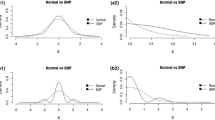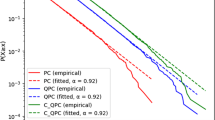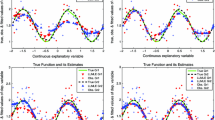Abstract
We show that inventive productivity can be described by two variables, Frenquency and Lifetime. For several samples of inventors, we show that the Exponential and Generalized Pareto distributions provide excellent goodness-of-fit to these variables. Furthermore, good fits to these distributions arises naturally from the statistics of exceedance. Thus, a better theoretical foundation and connection to environmental variables is shown for Frequency and Lifetime than has been shown for Lotka's Law.
Similar content being viewed by others
References
Lotka, A. J., The Frequency of Distribution of Scientific Productivity,Journal of the Washington Acad. of Science, 16 (1926) 317–323.
Pao, M. L., An Empirical Examination of Lotka's Law,Journal of the American Society for Information Science, 37 (1986) 26–33.
Leavens, D. H., Letter to the Editor,Econometrica, 21 (1953) 630–632.
Murphy, L. J., Lotka's Law in the Humanties?,Journal of the American Society for Information Science, 1 (1973) 461–462.
Voos, H., Lotka and Information Science,Journal of the American Society for Information Science, 25 (1974) 270–272.
Pao, M. L., Bibliometrics and Computational Musicology,Collection Management, 3 (1979) 97–109.
Narin, F., Breitzman, A., Inventive Productivity,Research Policy, 24 (1995) 507–519.
Huber, J. C., Invention and Inventivity as a Special Kind of Creativity, with Implications for General Creativity,Journal of Creative Behavior, 32 (1998a) 58–72.
Huber, J. C., Invention and Inventivity is a Random, Poisson Proces: A Potential Guide to Analysis of General Creativity,Creativity Research Journal, 11 (1998b) 1–241.
Mantell, L. H., On Laws of Special Abilities and the Production of Science Literature,American Documentation, 17 (1966) 8–16.
Sichel, H. S., A Bibliometric Distributions which Really Works,Journal of the American Society for Information Science, 36 (1985) 314–321.
Burrell, Q. L., Fenton, M. R., Yes, the GIGP Really Does Work— and is Workablel,Journal of the American Society for Information Science, 44 (1993) 61–69.
Allison, P. D., Inequality and Scientific Productivity,Social Studies of Science, 10 (1980) 163–179.
Wagner-Döbler, R., Where has the Cumulative Advantage Gone? Some Observations about the Frequency Distribution of Scientific Productivity, of Duration of Scientific Participation, and of Speed of Publication,Scientometrics, 32 (1995) 123–132.
Gupta, B. M., Karisiddappa, C. R., Productivity of Authors as Reflected by Duration of Their Scientific Participation and Speed of Publication,Scientometrics, 39 (1997) 281–291.
McReynolds, P., Reliability of Ratings of Research Papers.American Psychologist, 26 (1971) 400–401.
Zuckerman, H., Merton, R. K., Patterns of Evaluation in Science: Institutionalization, Structure and Functions of the Referee System,Minerva, 9 (1971) 66–100.
Bowen, D. D., Perloff, R., Improving Manuscript Evaluation Procedures,American Psychologist, 27 (1972) 221–225.
Mahoney, M. J., Publication Prejudices: An Experimental Study of Confirmatory Bias in the Peer Review System,Cognitive Theory and Research, 1 (1977) 161–175.
Lindsey, D., Assessing Precision in the Manuscript Review Process: A Little Better than a Dice Roll,Scientometrics, 14 (1988) 75–82.
Lindsey, D., Precision in the Manuscript Review Process: Hargens and Herting Revisited,Scientometrics, 22 (1991) 313–325.
Hargens, L. L., Herting, J. R., Neglected Considerations in the Analysis of Agreement Among Journal RefereesScientometrics, 19 (1990), 91–106.
U. S. Patent and Trademark Office, Manual of Patent Examining Procedure, U. S. Government Printing Office, Washington, DC, 1996.
Pelz, D. C., Andrews, F. M., Scientists in Organizations: Productive Climates for Research and Development. Institute for Social Research, The University of Michigan, Ann Arbor, MI, 1976.
Simonton, D. K.,Scientific Genius: A Psychology of Science. Cambridge University Press New York, 1988, p. 188.
Scott, S. G., Bruce, R. A., Determinants of Innovative Behavior: A Path Model of Individual Innovation in the Workplace.Academy of Management Journal, 37 (1994) 580–607.
Amabile, T. M., Conti, R., Coon, H., Lazenby, J., Herron, M., Assessing the Work Environment for Creativity,Academy of Management Journal, 39, (1996), 1154–1184.
Bennis, W., Cultivating Creative Genius, Industry Week, Aug 18 (1997) 84–88.
Mumford, M. D., Simonton, D. K., Creativity in the Workplace: People, Problems, and Structures,Journal of Creative Behavior, 31 (1997) 1–6.
Kanter, R. M., Kao, J., Wiersema, F.,Innovation: Breakthrough Thinking at 3M, DuPont, GE, Pfizer, and Rubbermaid, HarperCollins, New York, 1997, p. xv
Boorstin, D. J.The Americans: The Democratic Experience, Random House, New York, 1973.
Birr, K.,Pioneering in Industrial Research: The Story of the General Electric Research Laboratory. The Public Affairs Press, Washington, DC, 1957.
Broderick, J. T.,Willis Rodney Whitney: Pioneer of Industrial Research. Fort Organe Press, Albany NY, 1945.
Hasek, G., Manufacturing's Elite 100,Industry Week, Aug 17 (1998) 36–77.
Drucker, P. F.,Concept of the Corporation. The John Day Co., New York, 1946.
Drucker, P. F.,Concept of the Corporation (2nd ed.) The John Day Co, New York, 1972.
De Lorean, J. Z.,On a Clear Day You Can See General Motors, Wright Enterprises, Grosse Point, MI, 1979.
Hirshberg, J.,The Creative Priority: Driving innovative business in the real world. Harper Business, New York, 1998.
Huber, J. C., The Underlying Process Generating Lotka's Law and the Statistics of Exceedances,Information Processing & Management, 34 (1998c) 471–487.
Huber, J. C., Cumulative Advantage and Success-Breeds-Success: The Value of Time Pattern Analysis,Journal of the American Society for Information Science, 49 (1998d) 471–476.
Schuster, E. F., Exchangability and Recursion in the Conditional Distribution Theory of Number and Length of Runs, InA. P. Godbole andS. G. Papastavridis (Eds.),Runs and Patterns in Probability: Selected Papers (pp. 91–118). Boston MA: Kluwer Academic Publishers, (1994) 91–118.
Hamburg, M.,Statistical Analysis for Decision Making. Harcourt, Brace, Jovanovich, New York, 1977.
Lehmann, E. L., D'Abrera, H. J. M.Nonparametrics: Statistical Methods Based on Ranks Holden-Day, San Francisco, 1975.
Brownlee, K. A.,Statistical Theory and Methodology: In Science and Engineering, John Wiley & Sons, New York, 1965.
Horner, K. L., Rushton, J. P., Vernon, P. A., Relation Between Aging and Research Productivity of Academic Psychologists,Psychology and Aging, 1 (1986) 319–324.
McCrae, R. R., Arenberg, D., Costa Jr., P. T., Declines in Divergent Thinking With Age: Cross-Sectional, Longitudinal, and Cross-Sequential Analyses,Psychology and Aging, 2 (1987) 130–137.
Simonton D. K., Creative Productivity: A Predictive and Explanatory Model of Career Trajectories and Landmarks,Psychological Review, 104 (1997) 66–89.
Stephan, P. E., Levin, S. G.,Striking the Mother Lode in Science: The Importance of Age, Place, and Time. Oxford University Press, New York, 1992, p. 72.
Schubert, A., Glänzel, W., A Dynamic Look at a Class of Skew Distributions. A Model with Scientometric Applications,Scientometrics, 6 (1984) 149–167.
Johnson, N. L., Kotz, S., Kemp, A. W.,Univariate Discrete Distributions (2nd ed.), John Wiley & Sons, New York, 1993.
D'Agostino, R. B., Graphical Analysis, InR. B. D'Agostino andM. A. Stephens (Eds),Goodness of Fit Techniques (pp. 461–496). New York: Marcel Dekker, (1986).
Klein, J. P., Moeschberger, M. L.,Survival Analysis: Techniques for Censored and Truncated Data. Springer-Verlag, New York, 1997 pp. 389–400.
Johnson, N. L., Kotz, S., Balakrishnan, N.,Continuous Univariate Distributions (2nd ed., Vol. 1). John Wiley & Sons, New York, 1994 p. 494.
Balakrishnan, N., Basu, A. P., (Eds.),The Exponential Distribution: Theory, Methods and Applications. Gordon and Breach, Amsterdam, 1995 p. 1.
Klein, J. P., Moeschberger, M. L.,Survival Analysis: Techniques for Censored and Truncated Data. Springer-Verlag, New York, 1997 p. 44.
Stephens, M. A., EDF Statistics for Goodness of Fit and Some Comparisons.Journal of the American Statistical Association, 69 (1974) 730–737.
Stephens, M. A., Tests Based on EDF Statistics, InR. B. D'Agostino andM. A. Stephens (Eds.),Goodness of Fit Techniques (pp. 97–193). New York: Marcel Dekker, (1986).
Kaplan, E. L., Meier, P., Nonparametric Estimation from Incomplete Observations,Journal of the American Statistical Association 53 (1958) 457–481.
Parmar, M. K. B., Machin, D.,Survival Analysis: A Practical Approach, John Wiley & Sons, New York, 1995.
Crowder, M. J., Kimber, A. C., Smith, R. L., Sweeting, T. J.,Statistical Analysis of Reliability Data. Chapman & Hall, New York, 1991.
Klein, J. P., Moeschberger, M. L.,Survival Analysis: Techniques for Censored and Truncated Data. Springer-Verlag, New York, 1997 p. 84–96.
Johnson, N. L., Kotz, S., Balakrishnan, N.,Continuous Univariate Distributions (2nd ed., Vol. 1). John Wiley & Sons, New York, 1994, pp. 628–722.
Davis, H. T., Feldstein, M. L., The Generalized Pareto Law as a Model for Progressively Censored Survival Data,Biometrika, 66 (1979) 299–306.
Embrechts, P., Kluppelberg, C., Mikosch, T.,Modelling Extremal Events for Insurance and Finance Springer, Berlin, 1997 p. 294.
Pickands, J. III, Statistical Inference Using Extreme Order Statistics,The Annals of Statistics, 3 (1975) 119–131.
Johnson, N. L., Kotz, S., Balakrishnan, N.,Continuous Univariate Distributions (2nd ed., Vol. 1). John Wiley & Sons, New York, 1994, pp. 614–620.
Embrechts, P., Kluppelberg, C., Mikosch, T.,Modelling Extremal Events for Insurance and Finance. Springer, Berlin, 1997, pp. 294–352.
Hosking, J. R. M., Wallis, J. R., Parameter and Quantile Estimation for the Generalized Pareto Distribution,Technometrics, 29 (1987) 339–349.
Drees, H., Refined Pickands Estimators with Bias Correction,Communications in Statistics–Theory and Methods, 25 (1996) 837–851.
Li G., Doss, H., Generalized Pearson-Fisher Chi-Square Goodness-of-Fit Tests, with Applications to Models with Life History Data,The Annals of Statistics, 21 (1993) 772–797.
Hawala, S., Wang, J.-L., A General Approach to Derive Chi-Square Type Goodness-of-Fit Tests for Lifetime Data, InN. P. Jewell, A. C. Kimber, Mei-Ling Ting Lee, andG. A. Whitmore (Eds.),Lifetime Data: Models in Reliability and Survival Analysis, (pp. 113–123). Boston, MA: Kluwer Academic., (1996).
Wang, personal communication, November 4, 1998.
Koziol, J. A., Goodness-of-Fit Tests for Randomly Censored Data,Biometrika, 67 (1980) 693–696.
Michael, J. R., Schucany, W. R., Analysis of Data from Censored Samples, In:R. B. D'Agostino andM. A. Stephens (Eds.),Goodness of Fit Techniques (pp. 461–496). New York: Marcel Dekker, (1986).
Moore, D. S., Tests of Chi-Squared Type. InR. B. D'Agostino andM. A. Stephens (Eds.),Goodness of Fit Techniques (pp. 63–96). New York: Marcel Dekker, (1986).
Castillo, E., Hadi, A. S., Fitting the Generalized Pareto Distribution to Data,Journal of the American Statistical Association, 92 (1997) 1609–1620.
Castillo, personal communication, Aug. 6, 1998.
Mitron Hirsch, N. D.,Genius and Creative Intelligence. Sci-Art Publishing, New York, 1931 pp. 235–236.
Rossman, J.,The Psychology of the Inventor: A Study of the Patentee. The Inventor's Publishing Co., Washington, DC, 1931 pp. 39–40.
MacKinnon, D. W., The Nature and Nurture of Creative Talent,American Psychologist, 17 (1962) 484–495.
Levitt, T., Creativity Is Not Enough,Harvard Business Review, May–June (1963) 72–83.
Taylor, C. W., Barron, F. (Eds.),Scientific Creativity: Its Recognition and Development. John Wiley & Sons, New York, 1963 pp. 385–396.
Mackworth, N. H., Originality,American Psychologist, 20 (1965) 51–66.
Telford, C. W., Sawrey, J. M.,The Exceptional Individual. Prentice-Hall, Englewood Cliffs, NJ, 1967 pp 191–192.
Wallas, G., Stages in the Creative Process. In:A. Rothenberg andC. R. Hausman (Eds.),The Creativity Question (pp. 69–73). Durham, NC, Duke University Press, (1976).
Austin, J. H.,Chase, Chance and Creativity; the Lucky Art of Novelty. Columbia University Press, New York, 1978 p. 112.
Barron, F., Harrington, D. M., Creativity, Intelligence and Personality,Annual Review of Psychology, 32 (1981) 439–476.
Simonton, D. K.,Scientific Genius: A Psychology of Science, Cambridge University Press, New York, 1988 p. 64.
Drucker, P. F.,Post-Capitalist Society. Harper Business, New York, 1993, p. 49.
Gardner, H.,Frames of Mind: The Theory of Multiple Intelligences. Basic Books, New York, 1993 pp. 316–320.
Feldman, D. H., Csikszentmihalyi, M., Gardner, H.,Changing the World: A Framework for the Study of Creativity, Praeger Publishers, Westport, CT, 1994 pp. 22–23.
Florman, S. C.,The Existential Pleasures of Engineering. St. Martins Griffin, New York, 1994, p. 183.
Loehle, C., A Critical Path Analysis of Scientific Productivity,Journal of Creative Behavior, 28 (1994) 33–47.
Sternberg, R. J., Lubart, T. I.,Defying the Crowd: Cultivating Creativity in a Culture of Conformity. The Free Press, New York, 1995, pp. 283–288.
Amabile, T. M.,Greativity in Context. Harper Collins Publishers, New York, 1996 p. 98.
Sternberg, R. J.,Successful Intelligence: How Practical and Creative Intelligence Determine Success in Life. Simon & Schuster, New York, 1996, pp. 191–192.
Reiter-Palmon, R., Mumford, M. D., Boes, J. O., Runco, M. A., Problem Construction and Creativity: The Role of Ability, Cue Consistency, and Active Processing,Creativity Research Journal, 10 (1997) 9–23.
Torrance, E. P.,Guiding Creative Talent, Robert E. Krieger Publishing Company, Huntinton, New York, 1976 reprint, original edition published by Prentice-Hall, Englewood Cliffs, NJ, 1963 p. 66.
Mansfield, R. S., Busse, T. V.,The Psychology of Creativity and Discovery. Nelson-Hill, Chicago, IL, 1981, p. 97.
Amabile, T. M., Gryskiewicz, S. S.,Creativity in the R&D Laboratory. Center for Creative Leadership, Greensboro, NC, 1987, p. 6.
Eisenberger, R., Learned Industriousness,Psychological Review, 99 (1992) 248–267.
Abra, J.,The Motives for Creative Work: An Inquiry with Speculations about Sports and Religion. Hampton Press, Creeskill, NJ, 1997 p. 44.
Rushton, J. P., Murray, H. G., Paunnonen, S. V., Personality Characteristics Associated with High Research Productivity, In:D. N. Jackson andJ. P. Rushton (Eds.),Scientific Excellence: Origins and Assessment (pp. 129–148). Thousand Oaks, CA: Sage Publications, (1987).
May, R.,The Courage to Create. WW Norton, New York, 1975 p. 20.
Roe, A., A Psychological Study of Physical Scientists,Genetic Psychology Monographs, 43 (1951) 121–239.
Roe, A., A Psychologist Examines 64 Eminent Scientists,Scientific American, 187, Nov (1952) 21–25.
Roe, A., A Psychological Study of Eminent Psychologists and Anthropologists, and a Comparison with Biological and Physical Scientists,Psychological Monographs: General and Applied, 67 (1953) 1–55.
Garfield, C.,Peak Performers. William Morrow, New York, 1986.
Getzels, J. W., Csikszentmihalyi, M., From Problem Solving to Problem Finding, InI. A. Taylor andJ. W. Getzels (Eds.),Perspectives in Creativity (pp. 90–116). Chicago: Aldine Publishing Co., (1975).
Couger, J. D.,Creative Problem Solving and Opportunity Finding. Boyd & Fraser, New York, 1995, p. 178.
Fry, A., The Post-It Notes Story,3M Today, Aug (1995) 3–5.
Gumbel, E. J.,Statistics of Extremes, Columbia University Press, New York, 1960.
Castillo, E.,Extreme Value Theory in Engineering. Academic Press, New York, 1988.
Price, D. J. D.,Little Science, Big Science. Columbia University Press, New York, 1963, p. 48.
Snedecor, G. W., Cochran, W. G.,Statistical Methods. (8th ed.), Iowa State University Press, Ames, IA, 1989 pp. 89–95.
Hamburg, M.,Statistical Analysis for Decision Making. Harcourt, Brace, Jovanovich, New York, 1977 p. 287.
Author information
Authors and Affiliations
Rights and permissions
About this article
Cite this article
Huber, J.C. Inventive productivity and the statistics of exceedances. Scientometrics 45, 33–53 (1999). https://doi.org/10.1007/BF02458467
Received:
Issue Date:
DOI: https://doi.org/10.1007/BF02458467




